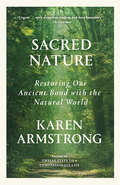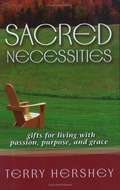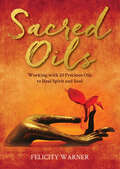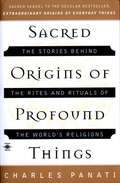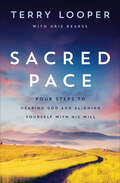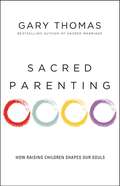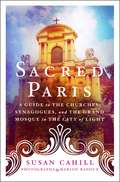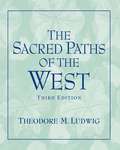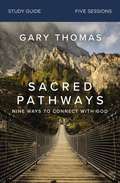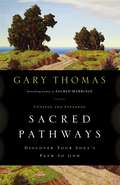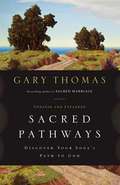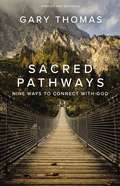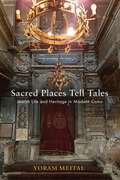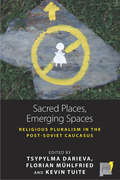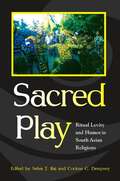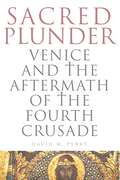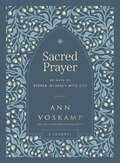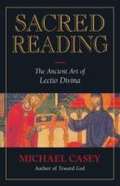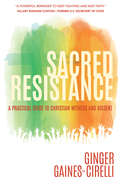- Table View
- List View
Sacred Nature: Restoring our Ancient Bond with the Natural World
by Karen ArmstrongA profound exploration of the spiritual power of nature—and an urgent call to reclaim that power in everyday life.Since the beginning of time, humankind has looked upon nature and seen the divine. In the writings of the great thinkers across religions, the natural world inspires everything from fear to awe to tranquil contemplation; God, or however one defined the sublime, was present in everything. Yet today, even as we admire a tree or take in a striking landscape, we rarely see nature as sacred.In this deeply powerful book, the bestselling historian of religion Karen Armstrong re-sacralizes nature for modern times. Drawing on her vast knowledge of the world's religious traditions, she vividly describes nature's central place in spirituality across the centuries: from the Book of Job to St. Thomas Aquinas, from Lao Tzu to Wordsworth, and from the Stoics to Jainism and beyond. Throughout, she reveals how we have lost our sense of the divine, and how we can get it back.Armstrong explores the power of silence and solitude, the nature of personal sacrifice and the need to reconnect with sorrow and compassion—and how greater contact with and appreciation for nature can help us in unexpected ways. In bringing this age-old wisdom to life, Armstrong shows modern readers how to rediscover nature's potency and form a connection to something greater than ourselves.
Sacred Nature: The Environmental Potential of Religious Naturalism
by Jerome A. StoneSacred Nature examines the crisis of environmental degradation through the prism of religious naturalism, which seeks rich spiritual engagement in a world without a god. Jerome Stone introduces students to the growing field of religious naturalism, exploring a series of questions about how it addresses the environmental crises, evaluating the merits of public prophetic discourse that uses the language of spirituality. He presents and defends the concept of religious naturalism while drawing out the implications of religious naturalism for addressing some of the major environmental issues facing humans today. This book is designed for undergraduate and graduate students, as well as scholars specializing in contemporary religious thought or environmental studies. ?
Sacred Necessities: Gifts for Living with Passion, Purpose, and Grace
by Terry HersheyWhat are the necessities? Grace. Stillness. Amazement. Sanctuary. Simplicity. Resilience. Friendship. "Is this book for you? It is a book for people who love life. And for people who wish to love life, but who are temporarily stymied. Captives to busyness, disappointment, exhaustion, anger, apathy, an excess of caution, or even a good reputation, we carry around an unused life-as if life is a savings bond to be withdrawn only when mandatory. Instead of living, we are star-struck. In a world of celebrities, we live vicariously through people who "have it all," ..."
Sacred Oils: Working with 20 Precious Oils to Heal Spirit and Soul
by Felicity WarnerDiscover the wisdom of a 4,000-year old sacred oil tradition, shared for the first time in written form!Sacred oils are part of a mysterious and ancient art that dates back thousands of years. Their knowledge is passed from master to master - only a handful of people alive hold this knowledge. Among them is Felicity Warner, a healer and myrrhophore.In this book, Felicity guides you through a healing journey with 20 of the world's most treasured oils, including Elemi, Holy Basil, Palo Santo and Spikenard. Detailing their history dating back to Egypt and Babylon, she explains how to: * mix, dilute, blend and store the oils * perform sacred rituals of anointment * attune to the frequency of each oil through meditation, and by using mandalas as a pathway to deeper consciousness * use the oils to cleanse auras and heal the soul, for prophecy and to access past-life information.<
Sacred Origins of Profound Things
by Charles PanatiIn this enlightening and entertaining work, Charles Panati explores the origins of hundreds of religious rituals, customs, and practices in many faiths, the reasons for religious holidays and sacred symbols, and the meanings of vestments, sacraments, devotions, and prayers. Its many revelations include: * Why the Star of David became the Jewish counterpart of the Christian cross * What mortal remains of the Buddha are venerated today * How the diamond engagement ring became a standard * That the first pope was a happily married man * How Hindu thinkers arrived at their concept of reincarnation * Why Jews don't eat pork, why some Muslims don't eat certain vegetables, and how some Christians came to observe meatless Fridays Sacred Origins of Profound Things is an indispensable resource for all those interested in the history of religion and the history of ideas--and an inspiring guide to those seeking to understand their faith.
Sacred Pace: Four Steps to Hearing God and Aligning Yourself with His Will
by Kris Bearss Terry LooperHow do we hear from God and discern His will when it&’s time to make big decisions? Terry Looper shares a four-step process for doing just that - a process he has learned and refined over thirty years as a Christian entrepreneur and founder of a multi-billion dollar company. At just thirty-six years old, Terry Looper was a successful Christian businessman who thought he had it all—until managing all he had led to a devastating burnout. Wealthy beyond his wildest dreams but miserable beyond belief, Terry experienced a radical transformation when he discovered how to align himself with God&’s will in the years following his crash and burn.Sacred Pace is a four-step process that helps Christians in all walks of life learn how toslow down their decision-making under the guidance of the Holy Spirit,sift through their surface desires and sinful patterns in order to receive clear, peace-filled answers from the Lord,gain the confident assurance that God&’s answers are His way of fulfilling the true desires he has placed in their hearts, andgrow closer to the One who loves them most and knows them best.Sacred Pace is not another example of name-it-and-claim-it materialism in disguise. Instead, it walks Christians through the sometimes-painful process of &“dying to self&” in their decisions, both big and small, so that they desire God&’s will more than their own.
Sacred Parenting: How Raising Children Shapes Our Souls
by Gary ThomasExplore the spiritual dynamics of parenting, and why caring for children is such an effective discipline in shaping our souls and forming the character of Christ within us.
Sacred Paris: A Guide to the Churches, Synagogues, and the Grand Mosque in the City of Light
by Susan CahillFrom the author of Hidden Gardens of Paris and The Streets of Paris comes a beautifully illustrated guide to the history of Paris through its renowned and beloved places of worship.When visiting the City of Light, the spirit of Paris can be felt everywhere. It holds a sacred history that goes beyond words, beyond religion, and its legendary places of worship are truly its crown jewels.Susan Cahill's Sacred Paris is a guide for seasoned Parisian visitors, novices, and armchair travelers to the historic religious sites of the city, from the well-known landmarks to the sacred spots off the beaten track, from the magnificent towers of Notre-Dame and the sweeping arches of the Grand Mosque to the serenity of Saint-Julien-le-Pauvre. This spiritual tour is interwoven with the artistic and cultural history of Paris, from the medieval Crusades through the Resistance of World War II. Stand in the basilica of Saint-Denis, where Joan of Arc prayed with her soldiers in the Hundred Years' War, and gaze at the murals of Saint-Sulpice painted by Eugene Delacroix, or visit the village of Auvers where Vincent van Gogh painted the lovely Gothic church of Notre Dame d’Auvers-sur-Oise.Organized by the major geographical sections of the city—Ile de la Cite; the Latin Quarter on the Left Bank; Montparnasse; Northern Paris on the Right Bank; the Marais—each chapter is accompanied by Marion Ranoux’s beautiful four-color photographs. Also included are lists of “Nearbys”: gardens, bistros, librairies, museums, and other points of interest to round out your visit.
Sacred Paths of the West
by Theodore M LudwigThis text combines study of the dynamic historical development of each religious tradition with a comparative thematic structure. Students are encouraged to discover and explore the nature of religious experience by comparing basic themes and issues common to all religions, finding connections with their own personal experiences. By sensitively introducing descriptive material within a comparative thematic structure, this text helps students to understand how each religion provides, for its adherents, patterns and meanings that make up a full way of life.
Sacred Pathways Bible Study Guide: Nine Ways to Connect with God
by Gary ThomasDiscover new ways of connecting with God by understanding how he uniquely created you to worship him. The Sacred Pathways video study will help you learn:How you naturally express yourself in your relationship with GodHow to develop new ways of drawing near to himKey biblical figures who share your spiritual temperamentHow to understand others who connect with the Creator differentlyAs believers in Christ, many of us today fall into the trap of thinking we have to approach God in a certain way. But our Creator made us all unique, and he designed us to connect with him in our own ways. For some, this might look like quiet contemplation. Others express praise through caregiving or theological discussions. It's important to discover the particular pathway that will best help you to experience God's presence.Bestselling author and speaker Gary Thomas reveals nine distinct spiritual temperaments to give you insight into how you naturally worship and how your personal walk with God might look different from those around you.Unlike the Enneagram and other personality assessment tools, Sacred Pathways gives you tools to investigate how you naturally relate to God. You will discover the strengths and impulses in your devotional approach so that you can eliminate the barriers that keep you locked into scripted methods of worship and praise.There is one thing that each of us as Christians can do that nobody else can--give our personal love and affection to God.This Study Guide includes:Discussion questions, reflection questions, and a personal assessment test to discover your pathwayPersonal Bible study for between sessionsA guide with best practices for leading groupsSessions include:The Journey of the Soul – Introduction to the PathwaysPathways of Wonder – the Naturalist, Sensate, and TraditionalistPathways of Contemplation – the Intellectual, Ascetic, and ContemplativePathways of Action – the Caregiver, Activist, and EnthusiastTending the Garden of the Soul – How the Pathways Apply to Your LifeDesigned for use with the Sacred Pathways Video Study available on DVD or streaming video, sold separately.
Sacred Pathways: Discover Your Soul's Path to God
by Gary L. Thomas"Thou Shalt Not Covet Thy Neighbor's Spiritual Walk." After all, it’s his, not yours. Better to discover the path God designed you to take--a path marked by growth and fulfillment, based on your unique temperament. In Sacred Pathways, Gary Thomas strips away the frustration of a one-size-fits-all spirituality and guides you toward a path of worship that frees you to be you. If your devotional times have hit a snag, perhaps it is because you’re trying to follow someone else’s path. This book unfolds nine distinct spiritual temperaments--their traits, strengths, and pitfalls. In one or more, you will see yourself and the ways you most naturally express your relationship with Jesus Christ. Whatever temperament or blend of temperaments best describes you, rest assured it’s not by accident. It’s by the design of a Creator who knew what he was doing when he made you according to his own unique specifications. Sacred Pathways will show you the route you were made to travel, marked by growth and filled with the riches of a close walk with God.
Sacred Pathways: Discover Your Soul's Path to God
by Gary ThomasThis revised and updated edition of Sacred Pathways will encourage you to see strengths, weaknesses, and tendencies in your devotional approach to God.
Sacred Pathways: Nine Ways to Connect with God
by Gary ThomasSacred Pathways reveals nine distinct spiritual temperaments--and their strengths, weaknesses, and tendencies--to help you improve your spiritual life and deepen your personal walk with God.It's time to strip away the frustration of a one-size-fits-all spirituality and discover a path of worship that frees you to be you. Experienced spiritual directors, pastors, and church leaders recognize that all of us engage with God differently, and it's about time we do too.In this updated and expanded edition of Sacred Pathways, Gary Thomas details nine spiritual temperaments and--like the Enneagram and other tools do with personality--encourages you to investigate the ways you most naturally express yourself in your relationship with God. He encourages you to dig into the traits, strengths, and pitfalls in your devotional approach so you can eliminate the barriers that keep you locked into rigid methods of worship and praise.Plus, as you begin to identify and understand your own temperament, you'll soon learn about the temperaments that aren't necessarily "you" but that may help you understand the spiritual tendencies of friends, family, and others around you.Whatever temperament or blend of temperaments best describes you, rest assured it's not by accident. It's by the design of a Creator who knew what he was doing when he made you according to his own unique intentions. If your spiritual walk is not what you'd like it to be, you can change that, starting here. Sacred Pathways will show you the route you were made to travel, marked by growth and filled with the riches of a close walk with God.
Sacred Places Tell Tales: Jewish Life and Heritage in Modern Cairo (Jewish Culture and Contexts)
by Yoram MeitalCairo’s synagogues shed new light on the transformation Egyptian society and its Jewish community underwent from 1875 to the presentSacred Places Tell Tales is the previously untold history of Egyptian Jewry and the ways in which Cairo’s synagogues historically functioned as active institutions in the social lives of these Jews. Historian Yoram Meital interprets Cairo’s synagogues as exquisite storytellers. The synagogues still stand in Cairo, and they shed new light on the social, cultural, and political processes that Egyptian society and the Jews underwent from 1875 to the present. Studying old and new synagogues in the Egyptian capital, their locations, the items they stored, and the range of religious and nonreligious activities they hosted reveals the social heterogeneity and the diverse ways in which modern Jewish sociocultural identity was constructed within Cairo’s Sephardi, Ashkenazi, and Karaite communities. Meital contends that studying the congregations and the social services provided in synagogues reveals the local Jewish community’s customs, cultural preferences, socioeconomic gaps, and class divisions.Sacred Places Tell Tales narrates not only the past but also the unprecedented transformations that have occurred in recent years in Egypt. While only a handful of Jews live in Egypt, the preservation of Jewish heritage, first and foremost synagogues and cemeteries, enjoy a growing interest in public discourse and popular culture. This new desire to preserve Jewish heritage is inseparable from the ongoing public debate about Egyptian society, its characteristics, and its identity, past and present. By contextualizing Jewish heritage preservation in a longer Egyptian and Jewish history, Meital opens a window into one of the most significant political discussions dividing Egyptian society today.
Sacred Places, Emerging Spaces: Religious Pluralism in the Post-Soviet Caucasus (Space and Place #17)
by Tsypylma Darieva Florian Mühlfried Kevin TuiteThough long-associated with violence, the Caucasus is a region rich with religious conviviality. Based on fresh ethnographies in Georgia, Armenia, Azerbaijan, and the Russian Federation, Sacred Places, Emerging Spaces discusses vanishing and emerging sacred places in the multi-ethnic and multi-religious post-Soviet Caucasus. In exploring the effects of de-secularization, growing institutional control over hybrid sacred sites, and attempts to review social boundaries between the religious and the secular, these essays give way to an emergent Caucasus viewed from the ground up: dynamic, continually remaking itself, within shifting and indefinite frontiers.
Sacred Places, Sacred Teachings: Following the Footsteps of the Buddha
by Khenchen Konchog GyaltshenA guide to following the footsteps of the Buddha—for the pilgrim in India and at home.The holy sites of India—Bodh Gaya, Sarnath, Shravasti, and others— became holy because the Buddha blessed them by performing his enlightened activities there. When we become holy through our practice of the Buddha&’s instructions, then the places we go will be made holy, too. Through meditation practice, we can realize and capture what the Buddha described as the profundity of the mind, which is completely peaceful, free from elaboration, luminous, and uncompounded. In this wise, heartfelt, and indispensable guide, Khenchen Konchog Gyaltshen takes us on a journey through the major holy sites for Buddhist pilgrimage by offering profound teachings related to each of the sacred places. In Bodh Gaya, the site of the Bodhi tree and the Buddha&’s enlightenment, we learn of how the Buddha became enlightened and what it means to take refuge in him; we uncover the profundity of emptiness at the site where the Buddha expounded the Heart Sutra; at the place of the Buddha&’s passing, we learn that the legacy of his vast teachings came about through his perfection of bodhicitta—a core quality we can master, too. In chapters based on these and other sacred places, we find that the wisdom the Buddha uncovered is available to us all. The Buddha discovered total satisfaction, the ultimate achievement, and left instructions on how we, too, can achieve the same. We already have this great path; we just have to follow it. In that way, we experience the joy of following the footsteps of the Buddha.
Sacred Places: Where to find wonder in the world
by Clare Gogerty'You'll feel utterly transformed' - Sunday Times'Helps adds a spiritual depth to our wanderings' - The Simple ThingsWellness travellers are seeking transformative experiences - wellness is, by nature, a journey and a quest. The concept of transformative travel is about finding experiences through trips that shift perspective and allow digital detoxing, connection with oneself, nature, communities and a sense of the bigger picture in life.Sacred Places is a stunning new coffee table exploration for seekers of unusual and enlightening destinations, for both armchair travelling and as inspiration for future journeys. The book will be particularly focused on experiences, in addition to a full description of the place. For example, plant medicine ceremonies in South America, walking the Camino Way, Stonehenge on the winter solstice, wild swimming in Iceland's sacred hot springs and silent retreats. Entries also introduce the history and geography of the place, significant stories, dates to visit, myths, legends and ceremonies.
Sacred Places: Where to find wonder in the world
by Clare Gogerty'You'll feel utterly transformed' - Sunday Times'Helps adds a spiritual depth to our wanderings' - The Simple ThingsWellness travellers are seeking transformative experiences - wellness is, by nature, a journey and a quest. The concept of transformative travel is about finding experiences through trips that shift perspective and allow digital detoxing, connection with oneself, nature, communities and a sense of the bigger picture in life.Sacred Places is a stunning new coffee table exploration for seekers of unusual and enlightening destinations, for both armchair travelling and as inspiration for future journeys. The book will be particularly focused on experiences, in addition to a full description of the place. For example, plant medicine ceremonies in South America, walking the Camino Way, Stonehenge on the winter solstice, wild swimming in Iceland's sacred hot springs and silent retreats. Entries also introduce the history and geography of the place, significant stories, dates to visit, myths, legends and ceremonies.
Sacred Play: Ritual Levity and Humor in South Asian Religions
by Corinne G. Dempsey Selva J. RajFrivolity isn't always frivolous—sometimes it can be sacred. Sacred Play uncovers levity and playfulness in a variety of South Asian traditions where one might least expect to find it: in the heart of ritual. While stories recounting the antics of various South Asian deities circulate widely, this enlightening book intentionally departs from divinity-centered humor to focus on the playfulness of humans and their religious practices. This grassroots levity is both serious and lighthearted; it can be highly scripted or spontaneous and cast in shades of light or dark humor. Case studies of Hindu, Muslim, Christian, and Buddhist rituals examine instances of levity that challenge social or religious norms, in which mischievous deities inspire similar behavior among their devotees, and where playful competition incites serious consequences.Sacred Play explores how piety and levity can complement and complicate one another, enriching our understanding of both.Selva J. Raj (1952–2008) was Chair and Stanley S. Kresge Professor of Religious Studies at Albion College. His books include Dealing with Deities: The Ritual Vow in South Asia, also published by SUNY Press, and South Asian Christian Diaspora: Invisible Diaspora in Europe and North America. Corinne G. Dempsey is Associate Professor of Religious Studies at the University of Wisconsin–Stevens Point. She is author of Kerala Christian Sainthood: Collisions of Culture and Worldview in South India and The Goddess Lives in Upstate New York: Breaking Convention and Making Home at a North American Hindu Temple. Together they coedited Popular Christianity in India: Riting between the Lines and Miracle as Modern Conundrum in South Asian Religious Traditions, both also published by SUNY Press.
Sacred Plunder: Venice and the Aftermath of the Fourth Crusade
by David M. PerryIn Sacred Plunder, David Perry argues that plundered relics, and narratives about them, played a central role in shaping the memorial legacy of the Fourth Crusade and the development of Venice’s civic identity in the thirteenth century. After the Fourth Crusade ended in 1204, the disputes over the memory and meaning of the conquest began. Many crusaders faced accusations of impiety, sacrilege, violence, and theft. In their own defense, they produced hagiographical narratives about the movement of relics—a medieval genre called translatio—that restated their own versions of events and shaped the memory of the crusade. The recipients of relics commissioned these unique texts in order to exempt both the objects and the people involved with their theft from broader scrutiny or criticism. Perry further demonstrates how these narratives became a focal point for cultural transformation and an argument for the creation of the new Venetian empire as the city moved from an era of mercantile expansion to one of imperial conquest in the thirteenth century.
Sacred Plunder: Venice and the Aftermath of the Fourth Crusade (G - Reference, Information and Interdisciplinary Subjects)
by David M. PerryIn Sacred Plunder, David Perry argues that plundered relics, and narratives about them, played a central role in shaping the memorial legacy of the Fourth Crusade and the development of Venice’s civic identity in the thirteenth century. After the Fourth Crusade ended in 1204, the disputes over the memory and meaning of the conquest began. Many crusaders faced accusations of impiety, sacrilege, violence, and theft. In their own defense, they produced hagiographical narratives about the movement of relics—a medieval genre called translatio—that restated their own versions of events and shaped the memory of the crusade. The recipients of relics commissioned these unique texts in order to exempt both the objects and the people involved with their theft from broader scrutiny or criticism. Perry further demonstrates how these narratives became a focal point for cultural transformation and an argument for the creation of the new Venetian empire as the city moved from an era of mercantile expansion to one of imperial conquest in the thirteenth century.
Sacred Prayer: 90 Days of Deeper Intimacy with God (A Guided Journal)
by Ann VoskampExperience deeper connection with God through the six SACRED steps of prayer in this 90-day guided prayer journal.Ann Voskamp shares her own personal prayer practice to help you discover the power and beauty of prayer:SACREDStillness to know GodAttentiveness to hear GodCruciformity to surrender to GodRevelation to see GodExamine to return to GodDoxology to thank God Discover with Ann, that, when we retreat from the world to pray, to wait, to hope in God—we find true and beautiful perspective for our souls. Ann shares the six steps of SACRED prayer through this 90-day guided journey.Prayer, communion, and connection with God is a life-changing discipline and gift. Prayer will enhance your life by:Growing your relationship with and faith in GodTransforming you to be more like JesusAligning your thoughts and actions with the BibleReducing stress and worry and increasing your peace Take this sacred journey of prayer with Ann over the course of 90 days and see how God moves in your life and in your circumstances.When you need hope, the first place you should go is down on your knees.
Sacred Reading: The Ancient Art of Lectio Divina
by Michael CaseyExamines the Western tradition of lectio divina (a spiritual and prayerful approach to reading the sacred texts) in order to help readers expand their spiritual approach to living.
Sacred Reality, Digital Simulation: Ritual Form in Virtual Spaces (New Approaches to the Scientific Study of Religion #19)
by Enrico BeltraminiThis study explores the relationship between the sacred and the virtual, emphasizing the sacred as a divinely dependent, consecrated space activated through ritual, mediating between the profane and the holy. The central argument is that the virtual is fundamentally incompatible with the ritual form—a concept developed by Romano Guardini and others, including Joseph Ratzinger—which holds that the sacred is not merely acknowledged but made present through ritualized actions that require tangible, participatory engagement. Even if the virtual realm were acknowledged as real and retained both the bodily presence of the faithful and the Divine Presence, the rite would still be ineffective. Virtuality prevents the proper enactment of the rite, rendering it ineffective. At its core, the ritual form is performative, embodied, and consecratory. It requires physical presence, material elements, and a structured sequence of gestures, symbols, and words that together make the divine encounter possible. Their absence in virtual spaces disrupts ritual form, compromising its sacramental function.
Sacred Resistance: A Practical Guide to Christian Witness and Dissent
by Ginger Gaines-CirelliIn the midst of polarized communities and nations, religious leaders across the theological spectrum are seeking help with how to respond and lead in troubled times. The need for courage to speak out and act is ever-present, because every generation faces a new set of fears and troubles.Author Ginger Gaines-Cirelli pastors a church in the heart of Washington DC, adjacent to the White House, which actively works to bring justice and help for marginalized communities, refugees and immigrants, and the endangered earth. She inspires and leads this work through preaching and by organizing and developing strong leaders, deeply rooted in a well-developed theological understanding. Pastoral warmth and compassion characterize the recommended practices.Sacred Resistance addresses these questions, among others:• When Christians see that something is wrong in our nation or community, how and when should we respond? • When we see multiple instances of 'wrong', how do we choose which ones to address? • How can pastors and other leaders faithfully take risks without violating relationships with the congregation or denomination?• What historical, biblical, and theological safety nets can be relied on?• How can we take care of ourselves and one another, so that our ministries and lives are sustained?
